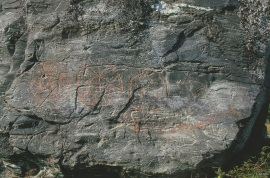- Remove Article filter Article
- Remove Archaeology filter Archaeology
- Remove Livelihood and Craftsmanship filter Livelihood and Craftsmanship
- Remove Place filter Place



Hæreid- archaeology
The biggest prehistoric burial site in Hordaland is situated at Hæreid. On top of the terrace expanse, inside the fine birch garden, is where they lie, the mounds and stone piles, on their own or in clusters, large and small, round and elongated – at least 350 in all.


Høybøen
In connection with the planned developments in the oil sector at Vindenes around 1980, excavations were carried out under the auspices of Bergen Historical Museum. Exceptionally interesting traces of an old farm at Høybøen then came to light. These were the remnants of a farm where there had been two houses containing several rooms.

Kinsarvik
Kinsarvik has probably been a centre for the inner Hardanger districts back in prehistory. History tells us that in medieval times there was a marketing place, a “kaupang”, here; a connecting point in the communications between east and west. There were supposedly around 300 residents here but the place was likely wiped out in a great fire.

Last Ice Age
The continental glacier that covered Hordaland was like a great power that had decisive influence over our natural history. The glaciers which at the beginning of the last ice age (more than 100,000 years ago) grew out from Folgefonna, Hardangerjøkulen and other mountainous areas, chased animals and birds, and most likely also humans in front of their paths. Small animals, plants and trees were mercilessly run over and crushed to powder under the thick ice. Even the hard bedrock got torn up and scoured by the ice, which did not give up before it reached the outer edges of the continental shelf. First 14,500 years ago, the climate became mild enough that the outer coastal strip of Hordaland once again became ice-free. Plants, animals and people started to migrate in to a landscape that was golden, with flecks of grey moraine and sand between smoothly polished rock outcrops - as our present warm interglacial was born.


Lurekalven
Lurekalven is an unpopulated island of heather moor which is a part of the wilderness belonging to the five farms on Ytre Lygra. Between the two islands there is only a small sound. As late as the 1920s, milking cows were rowed over the sound from Lygra in summer – a form of farming that was adapted to the coastal landscape.


